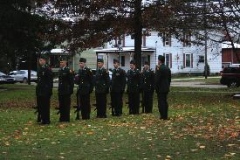Last Thursday, February 9, students and faculty attended a presentation given by one of PNC Bank’s spokesmen, William Adams, on the current recession in Europe and what it could mean for the U.S. economy.
“We’re not on the same level as Europe in terms of national debt. But the reason we don’t have the same crisis that Europe is having right now is because we have coherent national economic policy,” said Adams.
This policy allows for the federal government to use tax money collected from other states to keep the economy from collapsing completely in another state, said Adams.
Europe has a different economic system called a currency union, where 17 countries share the same currency, but are not under the same government, like the U.S., said Adams.
Adams went on to explain that being a part of a currency union requires the countries to agree on a common fiscal policy, which is how much money the government spends and how much they can collect for taxes. A common monetary policy, which sets the interest rate for an economy, is required as well.
The European economy is going downhill because taxes have gone up, the government spending has gone down, and a lot of government workers have been laid off. “That is probably two-thirds of the reason why Europe is in a recession right now,” Adams explained.
The other one-third of the reason is the investors. “The big issue right now is the banks,” said Adams.
As debt prices have gotten worse, European bank stock has lost about 60 percent of its value. “The higher you are in debt, the harder it is to borrow money,” said Adams
Some economists say that the European recession is just a passing thing and the euro should return to its normal value by the end of the year. “I’m a little more pessimistic about that because… it’s not because of a business cycle, or because the stock market went up or went down. It’s because the institutions they have don’t work,” said Adams.
Unemployment rates also reflect the condition of the economy. In Spain, there’s a 23 percent unemployment rate, which means that about one out of four workers aren’t able to find work. The rest of Europe is at about 10 to 15 percent unemployment.
In comparison, The PNC Northwest PA Market Outlook report says that while manufacturing industries have cut jobs over the years in the U.S. and younger residents have left northwestern Pennsylvania and other states in search of faster growing job markets, the job growth across the country has been encouragingly stable so far through the recovery.
According to The PNC Financial Services Group, “the job growth will average about 140,000 per month in 2012, adding up to 1.7 million new payroll jobs over the course of this year.”
“Our expectation is that we’re going to finish the year with unemployment under 8 percent,” Adams said.
While the U.S. is going to take a small hit from the recession in Europe, our coherent economic policy will allow our unemployment rates to lower and the labor market is starting to show signs of recovering
“Our debt problems are just as serious as Europe’s debt problems and our deficit is nearly as large as the deficit of other European governments,” acknowledged Adams. But the reason we don’t see the effects of it is because we have a better monetary policy and an independent currency, he said.
“We’re showing signs that we are on our way to recovering from this terrible recession that we’re now finally getting out of,” said Adams.
– Anna Tielmann (Taken from The Spectator Vol. III, Issue 16)

